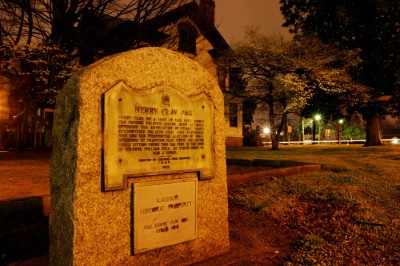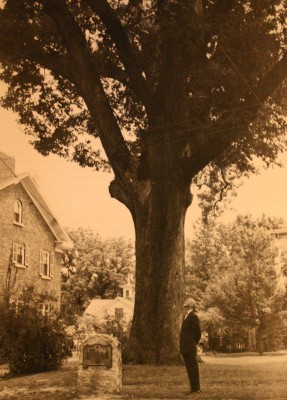Memorializing a Magnificent Oak and “The Great Pacificator”
Somewhat hidden on North Street near the intersection with Blount Street lies a historical marker denoting the location of what was until two decades ago likely the oldest White Oak in the City of Oaks. It was at this spot in which presidential candidate Henry Clay in the name of peace famously declared: “I’d rather be right than be president”.
The stone marker and bronze plaque which lie in the area of the Andrews Duncan House and across from the Heck-Andrews House (as well as the Bath Building) was erected in 1939 by the Wake County chapter of the Daughters of the American Revolution.
Henry Clay was the founder of the Whig Party and ran three unsuccessful bids for President of the United States. He was known as “The Great Pacificator” as well as “The Great Compromiser” for his abilities in bringing conflicting parties to agreement. He was Speaker of the House of Representatives and was held in high regard by fellow Kentucky native Abraham Lincoln.
The marker was placed directly in front of the White Oak tree under which he wrote the famous “Raleigh Letter” expressing opposition to annexation of Texas without the consent of Mexico, on the grounds it would lead to war.
Annexation and war with Mexico are identical. Now, for one, I certainly am not willing to involve this country in a foreign war for the object of acquiring Texas. I know there are those who regard such a war with indifference and as a trifling affair, on account of the weakness of Mexico, and her inability in inflict serious injury upon this country. But I do not look upon it thus lightly. I regard all wars as great calamities, to be avoided, if possible, and honorable peace as the wisest and truest policy of this country.
— Henry Clay, in an excerpt from a letter to the Editor of the National Intelligencer
It was this stance on avoiding war (as well as not taking a firm stance on the issue of slavery) which cost him the presidency by a narrow margin of victory (~38,000 popular votes).
Pictured above is the former director of Archives and History Dr. Henry Crittenden at the site of the marker and now absent oak tree in 1955. (image courtesy of Department of Archives and History)
The tree under which he wrote the famous letter was on the grounds of the Col. William Polk house. Clay’s friend and colleague Kenneth Rayner had inherited the house and used it to host the Presidential Candidate. The Polk house was moved in the 1870s and the Andrews Duncan house which now sits on the site was constructed shortly thereafter.
There are differing accounts of the oak tree’s age, ranging from 350 to 500 years old. In 1987 the tree was diagnosed with a deadly root fungus, but public sentiment temporarily delayed felling. In 1991 parts of the tree were falling to the earth in large pieces, and it was cut down in the latter part of that year.




 Sign up for the Newsletter
Sign up for the Newsletter
03/27/2009
John — You sure got that right — the Henry Clay Oak was indeed ‘magnificent!’ Thanks for spotlighting another of Raleigh’s ‘hidden’ monuments.
Thanks, too, for publishing the old photo of Dr. Crittenden. That’s a great shot of him standing beside the monument gazing up at the tree. I knew him well when I was a boy. ‘Dr.C’ passed away many years ago, but I always remember him with fond affection.
03/27/2009
Thank you for publishing the text of Clay’s Raleigh Letter. His words are still relevant to a country that is involved in two wars. Let us all hope our country finds Clay’s “honorable peace” soon.
“I regard all wars as great calamities, to be avoided, if possible, and honorable peace as the wisest and truest policy of this country.”
– Henry Clay, in an excerpt from a letter to the Editor of the National Intelligencer
03/27/2009
Yet Clay was the leader of the Warhawks, who pushed James Madison to declare war on Great Britain in 1812, in part because they wanted to use it as an excuse to invade and occupy Spanish-held Florida.
03/28/2009
RB – I wish I could have seen the tree in person. Do you know what is now the oldest oak in town?
Orion – I agree that words spoken 160+ years ago are still relevant today. Although technology and development change the environment we live in, humanity and politics often stay the same throughout the decades and centuries.
NCSU – I read that too, and was puzzled by his stance on that war in comparison to the one looming with Mexico. Perhaps he became more tempered in his older years?
03/28/2009
John – Gee, it’s hard to say. The Henry Clay Oak was by far the oldest and largest that was still around in my lifetime. We have lost a number of other large oaks in recent years to Hurricane Fran, disease and just plain indifference on the part of some property owners. There are a couple in the Confederate Cemetery and one at the foot of Tilden St. in Glenwood that come to mind. You have challenged me to a new quest!
And, as you noted re: Henry Clay — an astute observation, my friend!
03/28/2009
Henry Clay was definitely a war hawk before the War of 1812 when he was in his 30s, but he was 67 when he wrote this letter so eloquently against war. His wife’s brother, Captain Nathaniel G. T. Hart, died in the Massacre of the River Raisin in the War of 1812. He was one of 68 American wounded prisoners (mostly Kentucky militia) slaughtered when their fellow Americans had to leave them behind. Of 934 Americans who fought here, only 33 escaped death or capture. The fate of his brother-in-law and his fellow Kentuckians may have been on his mind as the US agitated for another war.
He also lost all six of his daughters to illness, and his son Henry Clay Jr. would be killed at the Battle of Buena Vista during the Mexican-American War 3 years after writing this letter.
I feel an urge to read more about this man and the effects the War of 1812 had on him.
10/26/2011
We have a collection from a fungus that was collected from near the base of that tree on about the 4th of November 1986. As I was trying to pinpoint the location I found this extremely helpful website. The fungus is Inonotus dryadeus and was probably collected by a student for a mycology class. The current name of the specimen is Pseudoinonotus dryadeus and is a wood rotter that was probably partly responsible for falling limbs.
I look forward to keeping up with Goodnight Raleigh. Thanks.
11/04/2012
A beautiful oak in Cary, NC is from the seedlings of the Henry Clay oak in Raleigh. If you visit the Page-Walker Hotel, you will see the tree and a marker describing the connection. Glad that the oak lives on!